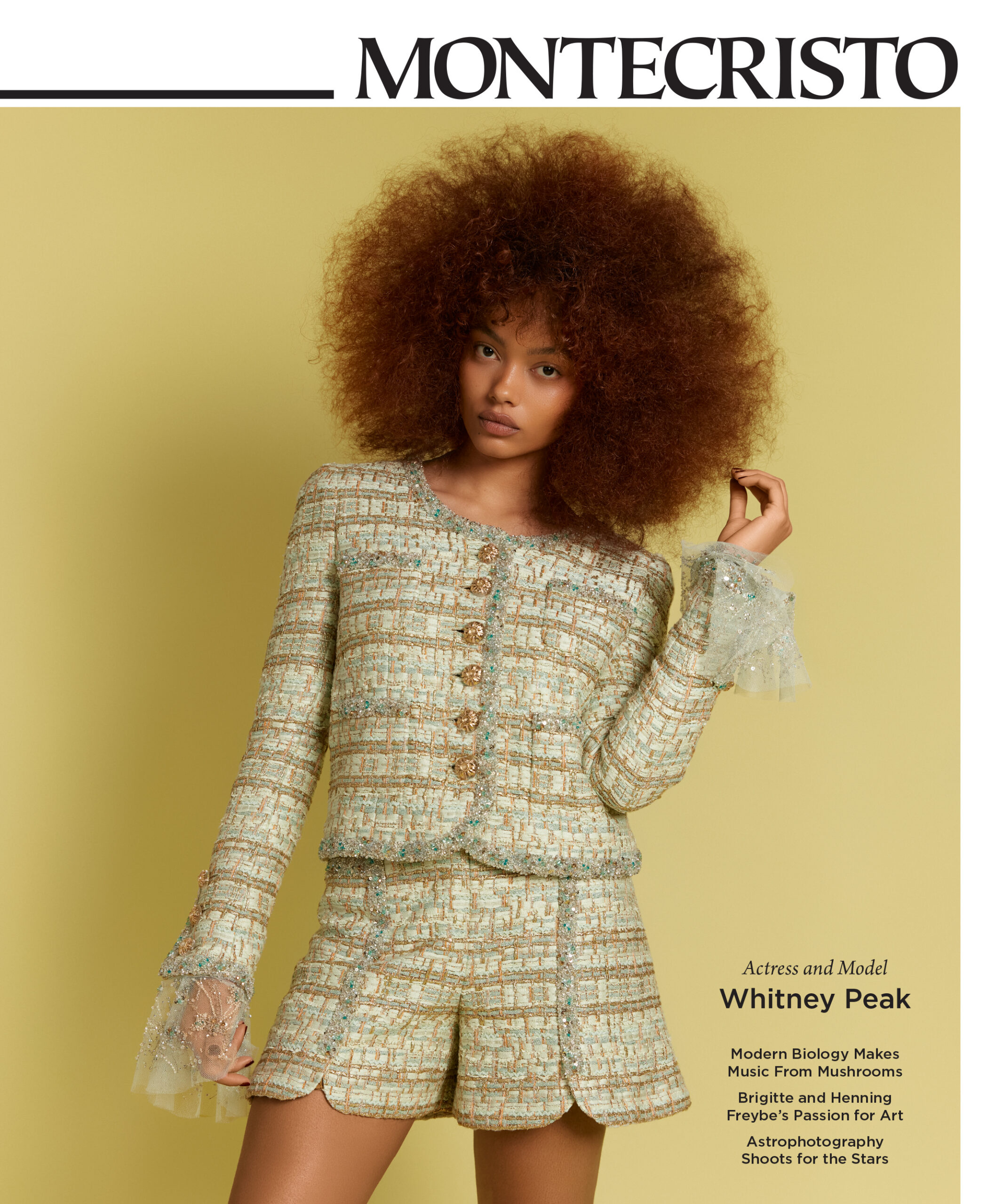A bar, 1985, somewhere in Hong Kong, after dark. Dead centre, the electric aqua grille of a jukebox glows, the only object not bathed in warm tones of red and pink. The interior is all sumptuous kitsch—a vase of fake lilies, padded chairs, and an ashtray, paintings of a nude bather and a pavilion, a Buddhist shrine lit with cheap electric bulbs. Photographer Greg Girard would later say that he didn’t set out to document the past, but in retrospect this image (Bar Interior, Hong Kong, 1985, from his book HK:PM), like much of his work, bleeds nostalgia. In an eerily parallel photo from Vancouver’s Chinatown in 1975 (Steams Cafe, 1975), a lonely jukebox and an abandoned parasol are framed by car silhouettes and a movie marquee, distinctly stamping time and place.
Girard’s work is stylized and unreal. “A photograph can be about what’s photographed, but also about something more,” he says in his 2017 book Under Vancouver 1972-1982. “Sometimes appearances don’t always align with what you know or suspect to be true. Photography seems able to show the surface and peel it back at the same time.”
Tannis Ling walks to the centre of an empty Meo, her new bar on East Pender Street, inspired by Girard’s photo. She stands feet together, hands folded, as if to shrink out of the way to allow full appreciation for the space. The restaurateur behind the 14-year Chinatown stalwart Bao Bei and the recently Michelin-starred Italian-Japanese fine dining room Kissa Tanto (upstairs from Meo), Ling has mostly avoided the spotlight, despite an increasingly unignorable presence in Vancouver’s food scene. She shrugs—Well, here it is.
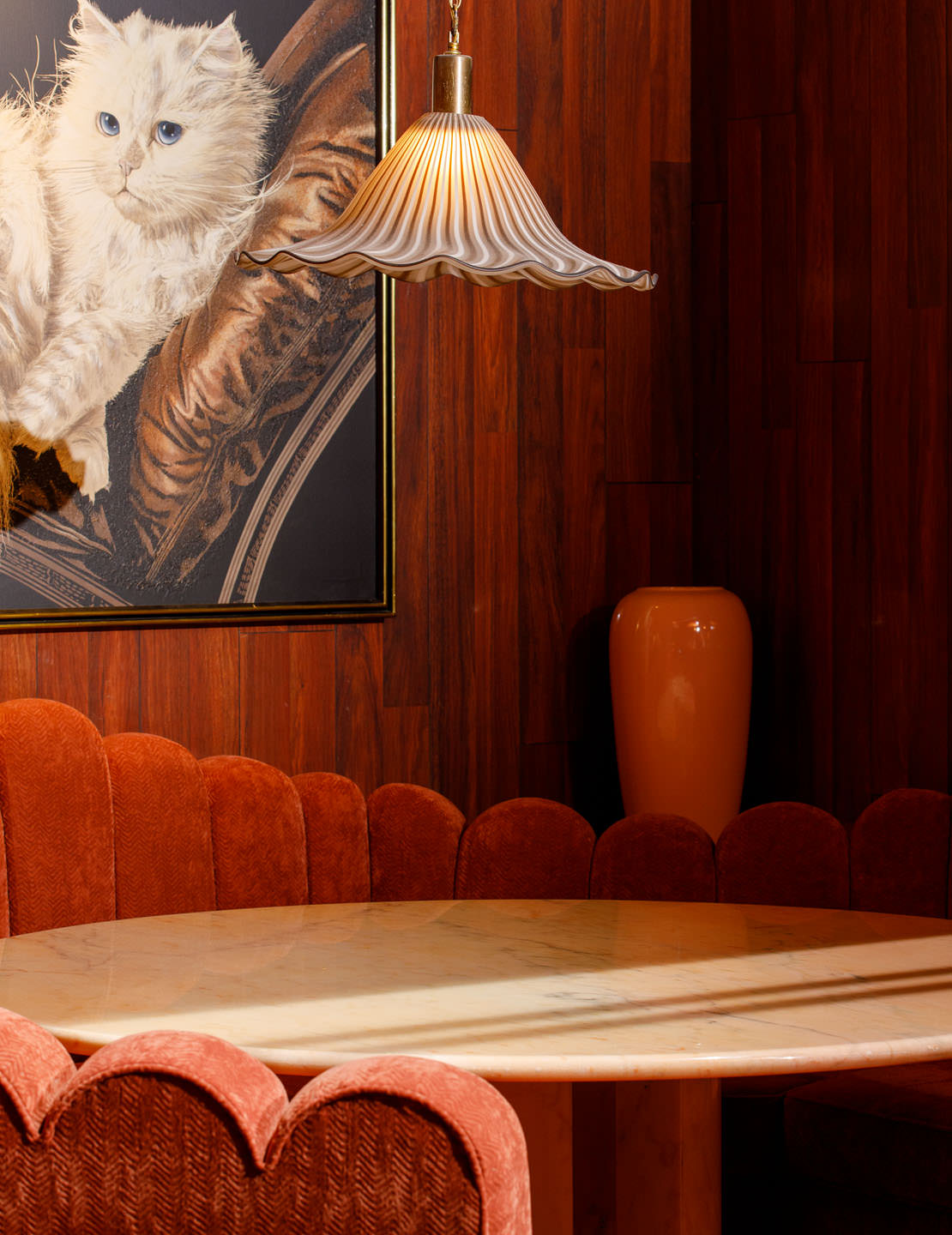
“People in Vancouver especially really want to feel a sense of escape,” she says matter-of-factly, as she looks around Meo. “And to be transported. It takes a lot of money to go out now, and you want to feel like where you’re going is worth what you’re spending.”
At night, with the lights low, an overhead mirror reflects an upside-down world above the bar—dizzying and slightly salacious.
Meo isn’t a facsimile of the bar in the photograph. Almost none of the details are the same, except the jukebox, with its uncannily similar neon blue. But Ling has captured how the picture feels—dingy, luxurious, empty, intimate. In her imagination, the bar is the lobby of a 1970s Hong Kong love hotel, not quite accurate but also something more than accurate. The seats are low and plush, lit by rosewood-toned pendant lamps shaped like modernist peonies. A painting of a large white cat, like you might find in a roadside antique shop, peers down on one nook.
At night, with the lights low, an overhead mirror reflects an upside-down world above the bar—dizzying and slightly salacious. It’s the one design element left over from Ling’s third project, the Singaporean small-plate bar Nancy Go Yaya, which closed in 2022. It was a hard lesson. “I was very, very afraid of coming up with the wrong concept again,” she says.
Ling is an unlikely restaurateur, at least of the calibre at which she operates. Most of Vancouver’s Michelin-starred restaurants are run by star chef-owners—Poirier, Carlson, Masayoshi, Stieffenhofer-Brandson… Ling doesn’t cook, though she’s found a more than able partner in executive chef Joël Watanabe. She’s not a trained business professional—she studied art history. She brings to the table extreme attention to detail and an immaculate grasp of vibes—an intangible skill set the power of which is, at this point, difficult to deny.
As she says: “I can tell a story.”
Ling grew up in Kerrisdale, her father an architect from Hong Kong and her mother a dentist from Taiwan who encouraged her to dig into the full breadth of Vancouver food—going out on weekends for sushi, dim sum, pho, and Korean barbecue. She took a break from UBC to make plentiful untaxed income working in bars on the Cayman Islands, spending it eating her way through Miami, Cuba, and Asia. Then, after graduation, she headed to London, where she bartended and fine-tuned her aesthetic sense: “There’s a bit of magic sauce in it. It’s from working in London, for sure,” she says. “The restaurant culture in London is 10 years, 15 years ahead of everywhere else.” She returned to Vancouver, making drinks at the since-closed West and then Chambar—celebrating its 20th anniversary this year—before taking the leap on her own with Bao Bei in 2010.
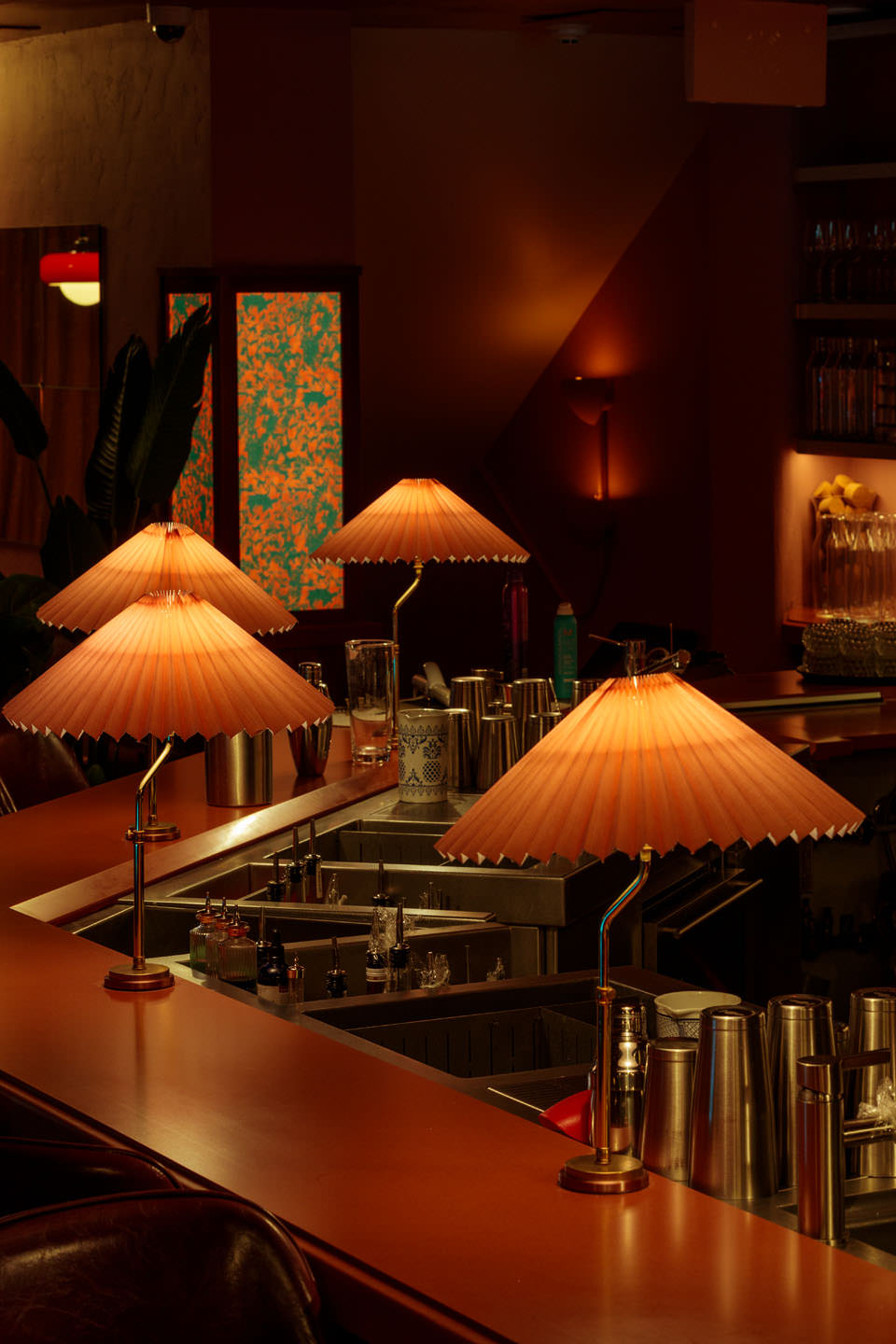
I ask her what she thinks gives Bao Bei its durability in the churning Vancouver hospitality market, and, as usual, she minimizes. “Everybody’s always told me I’m a details person, and I think that is kind of the key, paying attention to every single detail,” she says. “A lot of people in businesses have one or two aspects that they really excel at, that they do very well, like the food, or the design, or the service, or the music, or the lighting. But it’s difficult for everybody to get all those things done to the right levels.
“And obviously the food has to be amazing. Luckily, I have Joël.”
I ask Watanabe the same question—what makes Ling, and their partnership, so fruitful. He suggests it’s partly a dialogue between Ling’s simple, evocative ideas about Asian home cooking and his craftsman’s drive to deliver sophistication and finesse. It’s a high-low culture blend that has followed them from Bao Bei, where some of the most striking dishes are impossibly simple but totally distinctive—a plate of pea shoots, a bowl of marinated carrots, a pile of crisp fried eggplant.
“I’m that person with food, and she’s that person with aesthetics,” he says. “I don’t want to use the word avant-garde, but she’s ahead of the curve in terms of vision for things. But she’s real quiet about it.”
Along with Watanabe, Ling has carried a team along with her from Bao Bei to Kissa Tanto to Meo whom she trusts implicitly to realize and synthesize her vision. Another partner is designer Craig Stanghetta, who built his successful creative studio Ste. Marie after cutting his teeth on Bao Bei.
“We’ve had to drill it into the staff that they have to explain everything, that this is not what you’re going to expect.”
“We work in a deeply collaborative way,” he tells me. Ling is a font of ideas but also a hands-on designer, bringing back objects, pictures, and artwork from far afield that help build the narrative underlying each of her restaurants. “She’s very well travelled and deeply embedded in the world of food and drink, and has good taste in music and clothes,” he notes. “There’s just an innate sense of style, but it’s also not overly manicured or contrived—a lived-in, comfort, hosting kind of thing that bubbles underneath everything. I have a lot of trust in the ideas she brings,” he adds, “because I know that’s what makes a place both radically original but also welcoming and comfortable.”
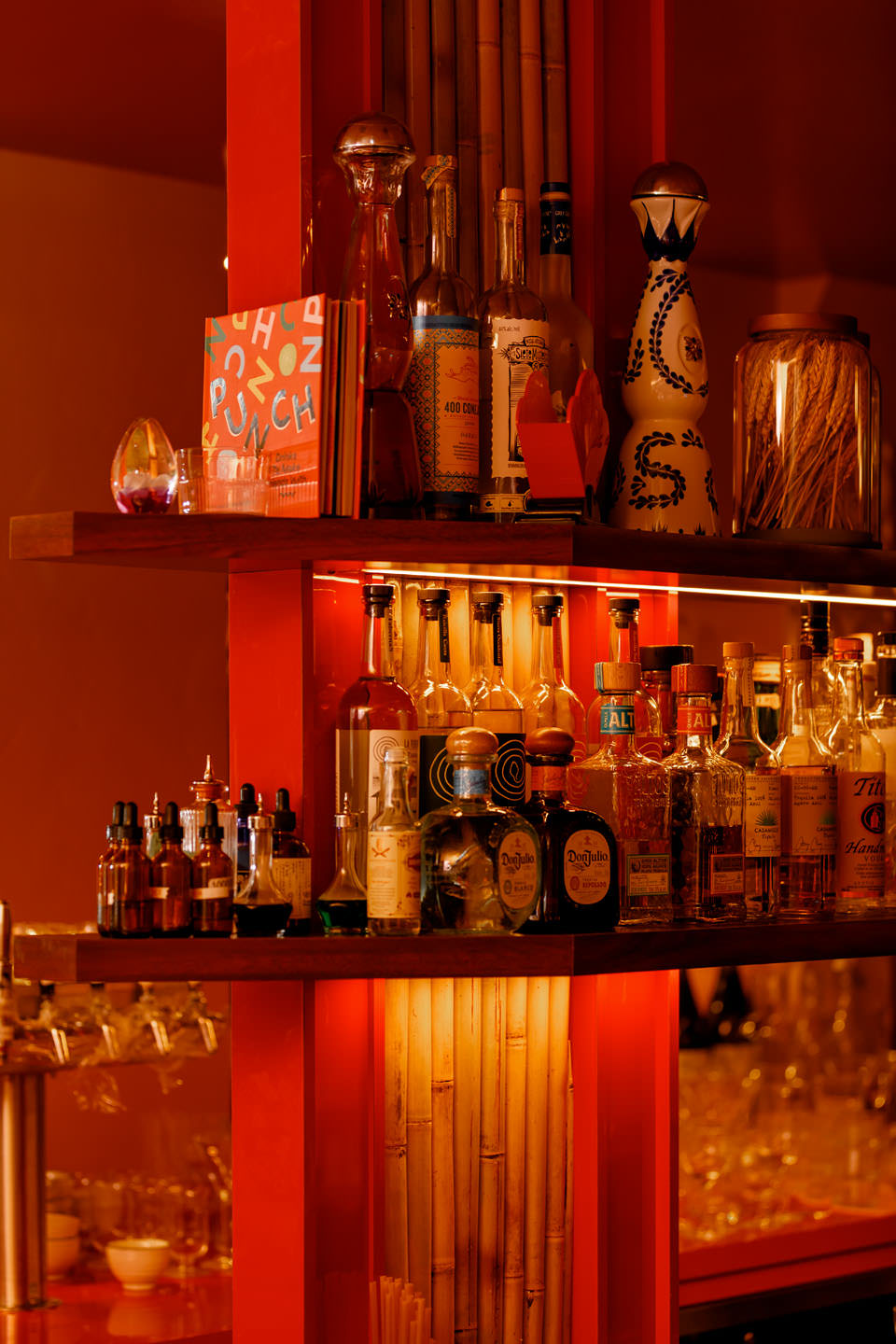
At Meo, Ling pushes her singular sense of taste a step beyond what she has before. When I return at night for a drink, I have been forewarned. The cocktails, dreamed up by Ling, Watanabe, and bar manager Denis Bykov, play on expectations of fruit and vegetable, sweet and savory—and are a touch challenging.
“We’ve had to drill it into the staff that they have to explain everything, that this is not what you’re going to expect, and to please read the ingredients,” Ling says, then chuckles. “There’s one drink that we actually have to keep warning about, like tell them that a lot of people hate it. And a lot of people love it. It’s very polarizing.”
Of course, I have to try it. The drink is an old fashioned, garnished with sweet-salty purple borage flower, rum, and bourbon washed with duck fat. The fat itself is gone, precipitated out when the liquor is chilled, but an intense, savoury duck flavour remains. The drink doesn’t quite taste like the oily broth that accompanies a good bowl of wonton, but it feels as if it does. I love it. I understand why some might not.
“This is a different kind of cocktail-making style,” Ling explains. “We pride ourselves on not being generic, and we’re pushing the envelope. There are a lot of places in town that take the easy route because they know people will order it and buy it and eat it and not complain or say anything. I think it’s not worth doing something if you’re going to do that, right? It’s not worth putting your heart and soul into a place and then serving ‘accessible’ things. And so, with the cocktail program, we knew it was going to be difficult for people to wrap their heads around, but these are things that I like to drink.”
I follow up the old fashioned with a martini, dirtied with two-week-fermented brined lychee juice. It is superbly dry, and the lychee has transformed into something vegetal akin to chilled asparagus, while a Shanghainese gin adds herbal and medicinal aroma. It is once again delicious, and like nothing I’ve ever tried.
“Next time you smell lychee, we want you to have this memory of savouriness that changes how you think about it,” Bykov tells me, leaning over the bar.
I think about memory walking back from Meo through cherry-blossom wreathed Chinatown, as Ling points out the local fishmonger where she buys her seafood—still wrapped in newspaper—for Kissa Tanto, and the medicine shops where Meo finds its herbs and spices among the dehydrated cowries and glass jars of tea. She points out that some of the new restaurants that signal Chinatown’s revival, such as Carol Lee’s Chinatown BBQ and Foo’s Ho Ho, speak to nostalgia for a real Chinatown gone by. But her version of nostalgia, she agrees, is something different—a more fanciful remembering, neither entirely fictional nor fact.
In an interview a few years ago, Greg Girard referenced a quote from Kingsley Amis that he “‘drinks to make people interesting.’ I worry that photography can be a similar intoxicant,” Girard said, “photographing the world to make it interesting.” At Meo, Ling leans into that liminality, taking a memory and making it brighter and stranger. A cocktail like a photograph. A photograph like a cocktail.
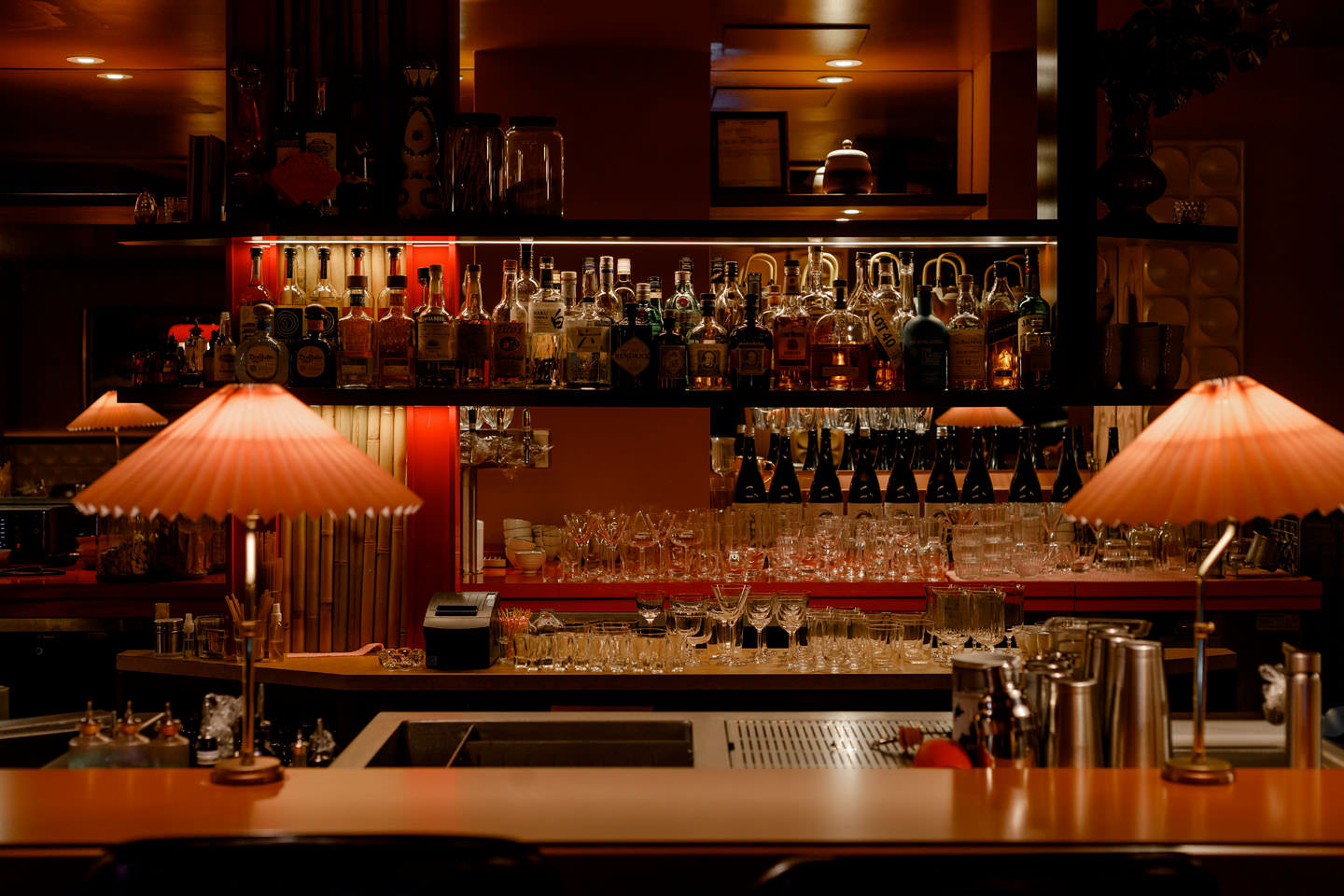
Read more from our Summer 2024 issue.








